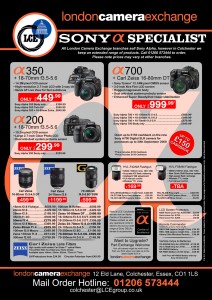Sony is ready to launch a GPS module
Sony can make GPS work. They pioneered it in the A55, refined it in the A77, A65 and A99 – and abandoned it without a word in all later A-mount cameras and the entire E-mount series. But they prepped the Multi Function Accessory Shoe to be used with a GPS module – and I believe it will be on the market soon.
They have put the rest of the architecture into the new cameras to make a GPS hardware module for the accessory shoe possible, practical, easy to implement and maybe even affordable (especially if third party makers come to the party).
This is a simulation using a retouched Elinchrom Skyport trigger – about the smallest size a GPS could be expected to be. For accuracy, something twice this scale mounted on the hotshoe would be a powerful four-aerial 2xAA cell or lith-ion powered GPS receiver.
Sony have added the I/O part of the data flow which puts geo data into the metadata fields of image files to the processor of the A9, A6500, RX10 MkIV (I think) and now the A7RIII – and in all three, they’ve put a 2.4GHz Bluetooth I/O process which can communicate with smartphones running their own GPS tracking app and grab the data every time you press the shutter. It needs no additional app on the camera.
This is significantly different from the Olympus solution (above), which I have also been testing alongside Sony’s. I have not found the A6500 pairing with iPhone all that reliable or persistent between sessions out of range or turned off. I have not enjoyed the Olympus method either – you synchronise the phone GPS app timecode and the camera time setting once using WiFi and after this you can turn WiFi off on the camera, leave the tracking app running on the phone, and shoot. At the end of the shoot, you connect again to the camera and initiate a transfer of the GPS track to the camera, which then parses it and embeds the co-ordinates closest to the timing of each exposure into the image files.
Sorry if this sounds a bit complex but it’s not. Essentially, Sony maintains a live link to the phone while you are shooting and acquires the GPS data to embed every time you make an exposure. Olympus relies on time synchronisation and an ‘end of day’ in-camera, wireless addition of the GPS data not unlike the process you might use with a separate tracker and a program like HoudahGeo or Photolinker.
That shoe has a GPS data channel – so far, unused. Now the processor has everything needed to make it work.
What’s really, really important is that these new Sony models have the firmware, interface connections and data handling to acquire a real-time or most recent position data packet from a stream, and inject this into your .ARW and .JPG files without needing any time synchronisation. Other models, which can not use the phone/Bluetooth solution, presumably do not have this firmware and the built-in protocols for acquiring, writing and validating. They don’t have the ready-made menu options either.
So, in place of your Bluetooth phone GPS, you will hopefully be able to fit a camera-top GPS module similar to those used by Canon and Nikon (who built the GPS data writing ability into their firmware years ago). The connections have been in the MFA shoe since 2010. Now the new camera models complete the jigsaw. All we are waiting for is for Sony to release a GPS module and a minor firmware update (the menu entries are already there). If the GPS module has its own battery, all the better – my tests with iPhone and A6500 ran the batteries on both down so fast the method would be impractical for anything more than day-trips.
I use GPS – at the moment, synchronising a track from an iGotU GT120 tracker carried in my camera kit or in a pocket. The device is not very reliable, has dodgy Windows-legacy management software and basic Mac function via third party programs. But for the travel photography I sell, captions have to be accurate and detailed, so the effort has to be taken. It was all SO much easier with the A55, A77 and A99… not to mention the Nikon D5300, Pentax K-1, or Sony’s non-raw-enabled Cybershot HX400V, HX60V and so on. For a very short time indeed I used the Jobo PhotoGPS, which required connection to a server database to turn its satellite position values into geocoordinates. Someone forgot to renew the licence, the server owners turned off the service, and every single PhotoGPS unit sold became a paperweight.
Nothing really beats having in in-camera or on-camera – and Sony has a good record of providing GPS assistance data files, auto-loaded on to your memory card when needed, which make the few cameras provided with GPS work well.
I had almost decided not to consider the A7RIII, but if my prediction proves right and the GPS module arrives in 2018 I will buy one. I’ve actually sold my A6500 after just three months of use to spend a bit of time using an Olympus E-M1 MkII outfit, including its slightly less battery-intensive GPS kludge. I’ve kept my A7RII as no camera made on the market at present, which is comparable in format, attains an image quality to match it when all other factors are equal.
Disclaimer: this is speculation. But it’s not empty speculation!
- David Kilpatrick




